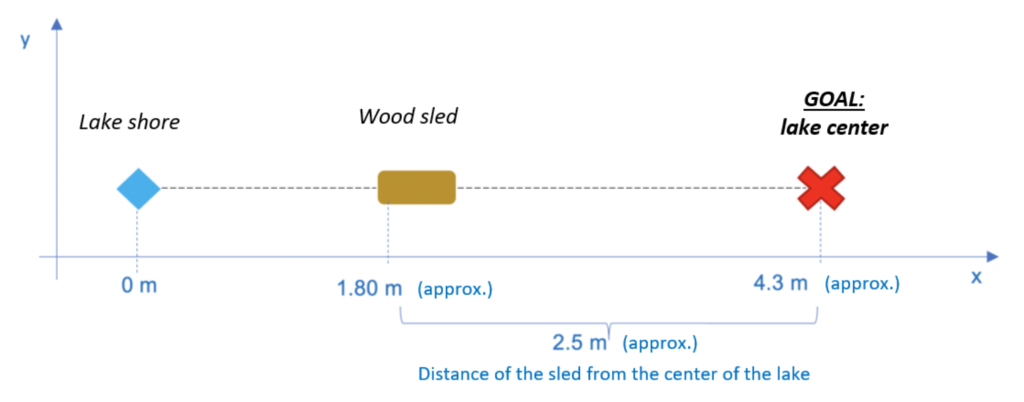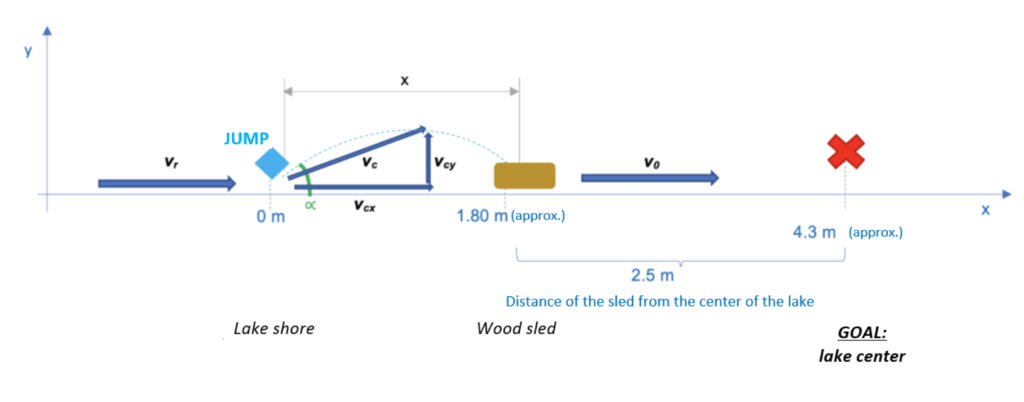Hello everyone, guys!
Some time ago, I received news of the possibility that, in ancient times, an ancient species of tuna could have gone as far as polar latitudes. Obviously, given the abstruseness of all this, I wanted to check for myself and I departed.
It was certainly not an easy expedition and, as expected, no trace of primitive frozen fossil tuna … I was also about to seriously risk not being able to get food for the return trip, if it wasn’t for physics, that still one once got me out of trouble and allowed me to remain unharmed.
On the way back, I was sailing on a river not yet completely frozen when my boat ran into threatening rapids and tumbled down a waterfall. I lost all the food, the tools, the notes… but don’t worry, my memory is iron! Unfortunately, I can’t say the same about my stomach, you have to live on something, what the heck! And science alone, as we know, only satisfies the mind.
I have wandered a lot in the vain search for something edible, but – alas! – at those latitudes, so close to the Arctic Circle, food certainly doesn’t abound and we walk along inaccessible paths. The cold had devastated my paws, but I knew I had to continue at all costs: from what I remembered seeing on the map, not far from the river from which I had escaped there should have been a lake. And lake meant fish, I had to believe it and to proceed at all costs. By that moment, this hope was the only force that moved my paws. Once I regained my strength and got some supplies, I could even reach a town and return to civilization.
I still had to light a few fires before seeing the much coveted stretch of water among the conifers, hunger had exhausted me. Then, you can imagine what anger when I discovered that the lake was completely frozen! Obvious, you say, at those latitudes what did you expected to find? Sure … I knew it very well, but part of me was expecting a stroke of luck…
Usually, the ice is less thick in the center and I might have had a chance to carve it with my nails to make a small hole and catch some fish. However, if I had walked on that hard, frozen surface, the damage to my paws would have been worse than that caused by the fresh snow up to that point, because it added the risk of sticking my pads to the ice itself.
I inspected the shore, looking for something that could help me and suddenly I saw it. No, it wasn’t a mirage: it was just a wooden sled about 1.5m / 2m from the shore. If I had managed to make a good leap, I would probably have been able to reach the center of the lake, also helped by the thrust that I would have given to the sled landing there after the jump.
Of course, if the ice or the sled had broken under my weight I would have been in real trouble … but fear is not part of a scientist like me and the calculations were on my side.
In the absence of papers, I began to trace my formulas and hypotheses with a stick in the snow. I’ll spare you the details that led me to conclusions (if you are interested, you can still request them from infopurr@astroartu.studio), but I want to explain to you in a scientific way because I was sure I would have done it.
First of all, I have divided the initial complex problem into a series of smaller problems, corresponding to the phases of my operation, starting from the goal and the estimate of some quantities that I would need in the calculations.

In fact, taking into account that my starting point on the lake shore was defined as the “zero point” = 0 m, I estimated that the sled could be about 1.8 m from the shore and that the center of the lake could be about 2.5 m from the sled itself (in the initial quiet conditions, of course). I’m pretty good with estimates of weights and distances, so I didn’t question my intuitions and introduced these numbers into the calculations.
Since I also needed the weight of the sled, I assumed that, in those abandoned and so battered conditions, it could not have weighed more than 3 kg. The doubt was whether it had withstood the impact with my weight, but at that moment it was not a hypothesis that I could afford to consider.
Here is a summary of the steps in solving the problem:
GOAL: get to the center of the lake, without touching the ice on the way, to catch some nice little fish.
- Calculate how fast the sled must have to reach the center of the lake after I jumped on it;
- Calculate how fast I need to be to reach the sled, in one leap, starting from the shore;
- Calculate what angle of jump I must have to reach the sled with the speed calculated in the previous point;
- Calculate the force to be used in the jump to have the parameters calculated in the previous points.
1. Calculation of the initial speed of the sled after the jump, to get me to the center of the lake.
Where:
v0= initial speed of the sled
g= gravity acceleration = 9.80665 m/s2
d= distance between sled and center of the lake = 2.5 m (circa)
k= coefficient of friction ice/ wood (circa 0.22)
2. Calculation of the speeds I must have in flight to get on the sled and to overcome its inertia.
This phase of the calculation is a bit more complex.
To start, the speed I must have in flight must be greater than that of the sled and I after the jump, since I have to overcome its inertia and make it move. This operation necessarily implies a loss of speed. By assuming, the principle of conservation of momentum states that my speed upon arrival on the sled is the same as that I assume during the jump.
The speed to be calculated is that of the movement horizontally, therefore the component of the speed itself along the x axis:
vcx = the x-axis component of my jumping speed between the shore and the sled (“c” is for “cat”…)
mc= my mass (5.5 kg)
ms= sled mass (hypothesized of 3 kg)
v0= initial speed of the sled (calculated in the previous step, and equal to 3.28440 m/s)
3. Calculation of the jump angle that I must have at the start, to get to the sled with speed = vcx
To solve this, we start with a system of equations with three unknowns:
The system is:
vc= my absolute speed during the jump (the magnitude of the x and y components of the velocity vector)
vcx= my speed along the x axis during the jump
vcy= my speed along the y axis during the jump
g = gravity acceleration = 9.80665 m/s2
x = distance shore – sled to travel 2 m (1.8 m + 0.2m to land on the sled)
α = jump angle
These formulas take into account that the vertical speed, together with the jump angle, must allow me to land on the sled and that the arrival speed on the sled vcx must be equal to the desired one, that is calculated in point 2: 5.07590 m/s
Moreover, for a ballistics principle, during the jump my behavior is similar to that of a bullet and my trajectory is parabolic; due to the symmetry of this curve, the jump angle and the arrival angle on the sled will be the same.
Substituting the first two in the third equation we obtain:
So I come to have:
- vc= 5.43115 m/s
- α= 20.84°
- x = 2 m
The results confirm that I will arrive at the desired speed on the sled and that I’ll land right in the middle, considering that I have estimated the distance from the closest point to the shore at 1.8 m. The jump must have an upward inclination angle of about 21 °.
4. Calculation of the force to be applied to the jump
To calculate the force, I need to estimate the time of the jump. From my previous experiences, I hypothesize its duration around 200 ms = 0.2 s (indicated as dt in the following calculations).
Since I need acceleration, I go through the decomposition of the speed vc (absolute speed in flight between the shore and the sled):
x component of acceleration:
y component of acceleration:
The acceleration of gravity must still be added to the component along the y axis, which I have to overcome to jump; therefore, the component along the y axis of the acceleration will be equal to 19.46665 m/s2
The resulting acceleration modulus is equal to:
Since for the second law of dynamics:
F=ma
The force I have to apply to jump will be equal to:
F= 5.5 kg 31.98546 m/s2= 175.92002N
Usually, no one is going to make a jump without foreseeing a run-up. So I thought about doing it too, but I had to calculate that at the moment of the take off an amount of speed is lost.
Therefore, the speed to be reached during the pre-jump run-up, to have a jump speed equal to vc = 5.43115 m/s , will have to be calculated as:
vr= run-up speed
vc= absolute speed during the jump
δ = estimate loss at the moment of the jump (I assumed a 20% = 0.2)
Summarizing in a graphic way:

Legend:
x = 2 m
vr = 6.07221 m/s
vc= 5.43115 m/s
vcx = 5.07590 m/s
vcy = 1.93200 m/s
α= 20.84°
v0 = 3.28440 m/s
Intrepid explorers who have followed me until the end of this explanation (which I realize is certainly very complex), here is how I managed to reach the center of the lake without touching the ice.
Piercing the frozen surface was not difficult and, after almost two hours of waiting, I managed to catch a nice fish, which filled me up and allowed me to accumulate a considerable supply for the return.
What a venture!
We’ll meet again at the next adventure… don’t forget to write me, if you have any questions, at:infopurr@astroartu.studio.
See you soon e and thank you for spending a little more time in my company!
Attention!:
Arthur Van is a cat who always works in extremely safety conditions.
The story of his adventure is undoubtedly compelling, but we do not know if he was really forced to do what he describes.
No cats have been thrown, or forced to jump, onto frozen lakes or other dangerous surfaces. Please do not throw cats, neither on dangerous surfaces, nor on any other type of surface.
Furthermore, we specify that the calculations refer strictly to the situation described and are intended for informational purposes only. Their validity in any real applications is not guaranteed.


